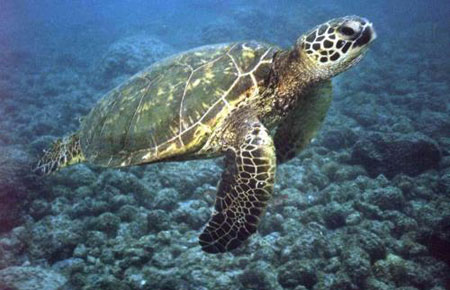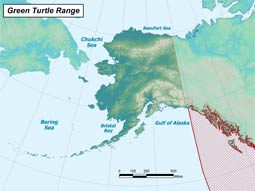Green Sea Turtle
(Chelonia mydas)
Species Profile
Did You Know?
Green sea turtles are the only herbivorous sea turtle.
Special Status Listing: Yes, see Status, Trends and Threats.
General Description
Sea turtles are large, aquatic reptiles with forelimbs specially modified for swimming. These front flippers are significantly larger than the back flippers. Their shell is composed of two pieces, the top, or carapace, and the bottom, or plastron. In most sea turtle species, the shell is made up of bony plates covered with horny shields.
Green sea turtles are the largest hard-shelled sea turtle reaching lengths of over 3 feet and weighing 300-350 pounds. They have a relatively small head compared to their body size. Their carapace is smooth and its color varies between individuals. It may be a shade of black, gray, green, brown, or yellow. The plastron is yellowish white. They have one claw on each flipper.
Life History
Growth and Reproduction
Green sea turtles reach sexual maturity between 20-50 years of age. After maturing, females nest every 2-4 years on their natal beaches. During the nesting season, females lay an average of 5 clutches of eggs with approximately two weeks between each nesting. Each clutch has an average of 135 eggs.
Eggs hatch approximately 2 months after being laid. The hatchlings, only 2 inches long, emerge from the nest and move into the water. After the hatchlings enter the ocean, it is believed that they travel to offshore areas to live for several years. Once the juveniles reach a certain size or age, they travel to nearshore foraging areas.
Feeding Ecology
Green sea turtles are herbivorous eating mostly algae and seagrasses. It is thought that this diet gives their fat its green hue. As hatchlings and juveniles, they feed on pelagic plants and animals near the surface in offshore areas. Adults transition to an exclusively herbivorous diet and feed in nearshore benthic habitats.
Migration
Green sea turtles undergo their first migration as hatchlings when they travel from their natal beaches to offshore areas to grow. Once the juveniles mature, they migrate to shallower coastal waters. In breeding years, adult females migrate from their coastal foraging areas to nesting beaches. These migrations may be hundreds to thousands of kilometers each way. The maximum migration is about 3,000 kilometers.
Range and Habitat
Green sea turtles use a variety of habitats. Oceanic beaches are used for nesting. Females need open beaches with a gentle slope and minimal disturbance. Adults use benthic foraging areas in coastal waters. They are generally attracted to bays and lagoons with a high density of seagrasses or algae. Hatchlings and juveniles spend their time in offshore convergence zones.
This species is distributed globally. Green sea turtles are most commonly found in tropical and subtropical waters along the coasts of continents and islands. In the eastern North Pacific, green sea turtles are seen from Baja California to southeast Alaska. In Alaska, there have been 15 green sea turtle sightings since 1960.
Status, Trends, and Threats
Status
The green sea turtle population is much lower than historic levels. Despite their low abundance, the population seems stable. The breeding populations of green sea turtles in Florida and on the Pacific coast of Mexico are listed as endangered under the Endangered Species Act (ESA). The remaining populations are listed as threatened. To learn more, visit the ADF&G Special Status page for green sea turtle.
NatureServe: Global – G3 (Vulnerable)
IUCN: Endangered
ESA: Endangered (Breeding populations in Florida and the Pacific coast of Mexico), Threatened (All other populations)
Trends
The population of green sea turtles has declined dramatically over the last 100-150 years. During this time, there has been an estimated 48–65% decline in the number of nesting females. This decline is attributed to the long-term harvest of eggs and adults on nesting beaches and adults and juveniles in foraging areas.
Threats
One of the main threats to green sea turtles is the continued harvest of turtles and eggs in some parts of the world. Bycatch in fisheries is also a major source of mortality. Green sea turtles are most often entangled in gillnets but are also caught in trawls, traps and pots, longlines, and dredges. In some regions, disease is a problem. Fibropapillomatosis is becoming increasingly common in green sea turtles in some parts of its range. This disease causes the formation of internal and external tumors. These tumors may interfere in vital processes and can lead to death in turtles with heavy tumor loads. Green sea turtles also suffer from habitat degradation and loss in areas where development has altered the beaches.
Fast Facts
-
Size
3 feet, 300–350 pounds -
Range/Distribution
Global, primarily in tropical and subtropical coastal waters -
Diet
Algae, seagrasses -
Predators
Hatchlings – Crabs, birds -
Reproduction
Nest every 2–4 years with multiple clutches in each nesting year -
Remarks
Managed by both the National Marine Fisheries Service and US Fish and Wildlife Service


